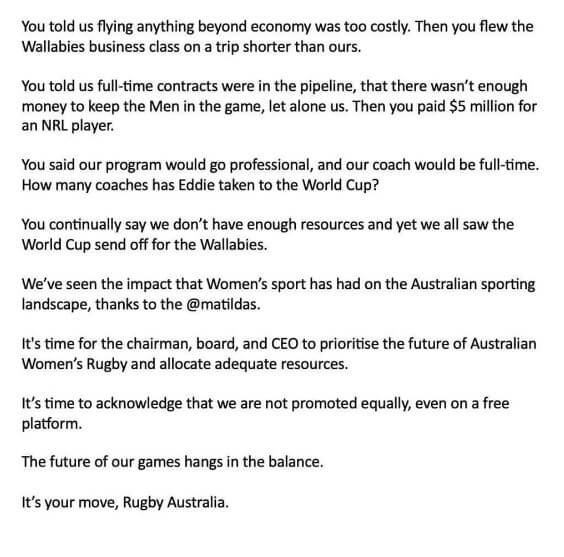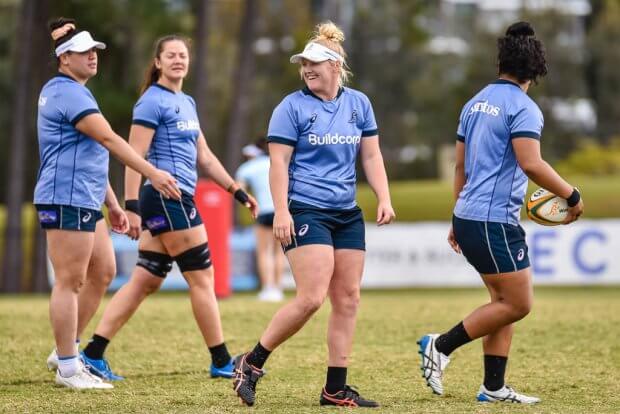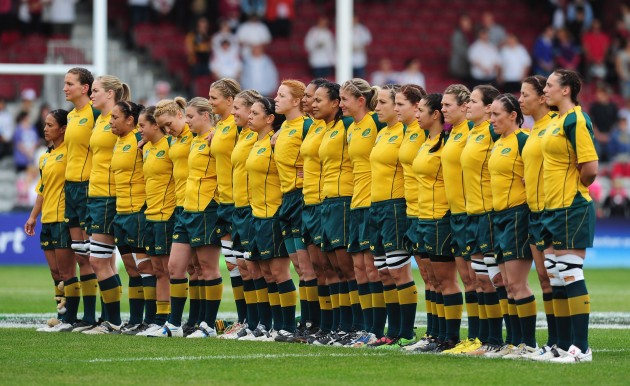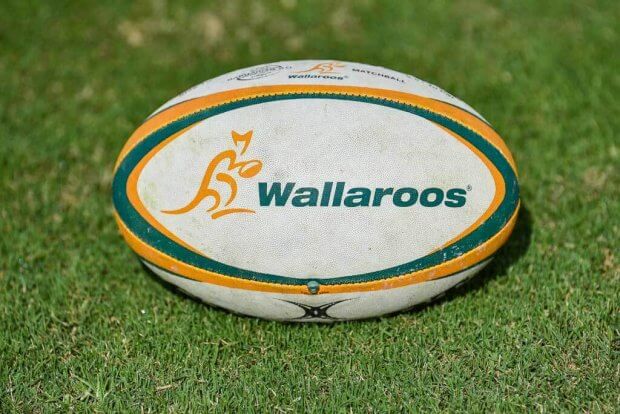A special edition G&GR column written by Kirby Sefo on the state of women’s rugby in Australia has been organised by Charlie, who apparently is John Farnhamesque in his ‘final article’.

WOMEN’S RUGBY IN AUSTRALIA by Kirby Sefo
My playing career was decorated with the many typical (but aspiring) highs of a female athlete including international dual code representation, professional contracts, multiple club premierships, Super W captaincy along with the feel-good emotions and memories filled up by lifelong friendships made and contributions to long standing legacies created. It also ran parallel to the typical lows of a female athlete including discrimination, sexual harassment, unaffordable salaries and varying mental health issues.
It sounds rather over the top to put such damming labels on an experience that we spend our lifetime working towards and are consistently encouraged to thrive for, so when asked to contribute an opinion piece around “how to make the pathway for women and girls in rugby union successful” I was genuinely stumped is to where I should begin.
How do we make pathways successful for women and girls in rugby union?
I wonder if this is truly the question we should be asking ourselves. There are so many moving parts to a player becoming successful in the high performance arena or not, that a blanket solution for all would doubtfully fix the current status of women’s rugby union in Australia. I think a more honest question to consider is “what is wrong with the pathway for women and girls in rugby union?”
If we can honestly and transparently answer that, there lies the starting point on how to fix a clearly declining buy-in for females to be involved with rugby union in Australia at any capacity.

In a recent uproar sparked by past and present Wallaroo players, a statement flooded social media platforms and newsfeeds highlighting the continued disparity between player treatment for women and men. When I was asked to share the statement and post, I without hesitation hit copy and paste and watched as the momentum flowed throughout. The comments, the shares, the likes – there is an obvious and huge sense of empathy that ‘the people’ are willing to share (in their opinion) what’s currently wrong with rugby union from grassroots through to high performance in Australia.
The Matildas have just shown us that women and historically male dominated sporting codes can co-exist to a point where the fanbase is overwhelming, ticket sales exceed availability, and the general public are ready to jump onboard the female-in-soccer bandwagon, and are willing to support the consumerism growth of a female-centric industry.
This growth and current trend will ultimately serve to answer the constant and monotonous response of “why should women get more money when no one watches the games?” or a favourite “I’d watch them play if they played better footy”. I’m sure everyone would perform quite well in life if financial security, welfare, and positive working conditions were prioritised for them.
However, before we criticise the governing body of “our great global game” and their attempts in finding equity among gender, you cannot look past the more recent progress to establish tiered payments to our national female players. A maximum earning capacity of $40k per year plus ‘on tour’ payments, along with a minimum earning capacity of $10k per year for our lowest tier plus ‘on tour’ payments. Outside of this, our super club squad members will receive $4k per season and it will be at the franchise discretion how they choose to support their female athletes thereafter.

This wouldn’t be an accurate ‘opinion’ piece without obviously injecting my personal opinion into the current situation and to jump on board the rugby union bandwagon of voicing out what I think is wrong with our current female pathways. I must preface that these are not isolated situations or scenarios rather than that of a former player’s reality who is no longer bound by the pressure to conform nor sit within a framework that does not serve me as a person, player and most importantly as a woman.
A short list and development of events experienced as a female player on a rugby union pathway over the past decade:
· Being told to take my runners to training in case there was no field space. The alternative was to train in the car park.
· Wearing men sized and men’s cut jerseys at representative level (for many years).
· Carrying a bucket for donations around a men’s game to fundraise my own attendance to a women’s game.
· Getting changed behind a single curtain held up in room full of men because I couldn’t change out in the open with them.
· Receiving a full-time wage that falls short of the national minimum wage or award rates.
· Suffering a diagnosed mental illness within a program resulting in a loss of contract.
· Experiencing bullying and sexual harassment in the workplace as a player and employee.
· Being contacted on private numbers (no longer as a player) demanding me to remove my posts and comments around competition structures and player profiles or experiences.
· Enduring facial/eye socket fractures (resulting in vision impairment) and being left interstate for 7 days due to injury. A suggestion was offered to potentially train or bus back to Queensland from Perth, WA as an alternative.
· Having verbal confirmation to compensate for the negligence and ill duty of care without in fact receiving anything.
Some experiences are more alarming than others and some may ask why raise these points at all. These points are disruptive and distracting to the growth of our game. These points display an attitude of ungraciousness, spite and are riddled with the attributes from a typical outspoken whistle blower, of the game.
These characteristics are far from how I feel about my time in rugby union. These were my lows, these were my coming undone and these are the reasons I won’t stop sharing. My highs are always celebrated. My home is decorated with framed jerseys of some of my proudest moments and achievements in rugby union. Albeit I didn’t represent Australia in any world breaking capped number of games, but my contribution across grassroots, community, national and international involvement is also among my gratifying tributes to the game.
The highs are not the moments we should consistently draw on when answering the question of “How do we make pathways successful for women and girls in rugby union?”
Because I can (and at this stage only want to) give you my thoughts and experiences of what is wrong with the pathways of rugby union.
It might be hard to hear. It might be confronting to read, and it might not be the focus we want to put the spotlight on. However, if we’re looking to make a historic reset of rugby in Australia then we need to reset the wrongs experienced by so many women as players, coaches, administrators, and volunteers of this “great global game”.

Where are our Wallaroos who acted with such conviction last Sunday? Our women who called out a national organisation for equity and change. After the fire was ignited and they the people seemingly jumped on board we were met with the appointment of a new male in high performance for women and the staple catch phrases of “we will continue to work with the women” “we will meet with the women’s leadership group” “we will continue to contribute to sustainable change”.
We’ve heard this all before. It’s been five days since the Wallaroos abruptly made such a staunch and deliberate stand yet nothing more has been said or shared by any of them. Not one.
The recommendations, frameworks and strategies put in place for women and girls in rugby union won’t be designed and delivered accurately to serve the women and girls in rugby if the current and past environments or experiences don’t depict exactly that. Accurate.
One of my most exciting memories to the Matildas’ recent World Cup is seeing the Australian women’s team exploding into the forefront of little girls dreams for future sporting aspirations. Sam Kerr is now joined by all of her teammates in popularity who provide visibility to the possibilities of what a future in sport might look like for a young female soccer player.
I want my daughter to know who Rebecca Tavo is. I want her to learn about the Cheryl Soons, Ash Hewsons and the Bo De la Cruzes of the game. I want my daughter to be on a pathway that a nation is getting behind because their fanbase is overwhelming, because their games are selling out and because the backing from the general public is saturated with supporters of women as athletes and only not to be known as ‘female athletes’.
How do we make the pathway for women and girls successful in rugby union?
If you want my truthful opinion and answer on this: keep being radical in your approach until you are heard. We the women in this current climate are not the decision makers. We don’t always have a seat at the table, and we don’t have positions behind the scenes to inject relevant and real examples of why change needs to happen. So be radical about it. Stop being silenced and keep giving an accurate representation of what it truly is to be a female in rugby union at the moment.
Keep sharing your experiences as an individual, as a woman and as a collective.


